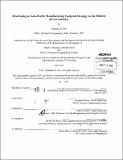Developing an Asia-Pacific manufacturing footprint strategy in the medical device industry
Author(s)
Dev, Nishanth K. (Nishanth Krishna)
DownloadFull printable version (11.84Mb)
Other Contributors
Leaders for Global Operations Program.
Advisor
Jonathan Byrnes and Charles Sodini.
Terms of use
Metadata
Show full item recordAbstract
As medical device manufacturers operating in the Asia-Pacific region are planning for increased demand in the near future, they must evaluate their manufacturing footprint strategies to determine if they are getting the most value out of their supply chains given the various incentives and costs associated with regional manufacturing. Company X is investigating manufacturing expansion opportunities for medical devices due to the significant revenue growth rates expected for the Asia-Pacific region, especially in the emerging markets. This thesis deals with the development of a repeatable methodology that can be used to evaluate various medical device products and manufacturing capabilities for Asia-Pacific sourcing. The methodology was tested on a selected subsidiary to determine if a regional manufacturing opportunity exists. Furthermore, a business process, which includes insights into data collection, team formation, and implementation of footprint decisions, was developed for Company X to use in determining its overall network strategy for the sector. Other manufacturers can apply the methodology and the business process in the development of their manufacturing footprint strategies as well. Although the results from the decision analysis did not favor expansion of the manufacturing operations for the selected Product Line B in the Asia-Pacific region, they helped in identifying the key factors that would favor regional expansion. In addition, crucial factors that may be difficult to quantify, such as intellectual property rights, must be considered before making a expansion decision, even if it is the favored outcome based on the results of the decision analysis for other product lines or subsidiaries.
Description
Thesis (M.B.A.)--Massachusetts Institute of Technology, Sloan School of Management; and, (S.M.)--Massachusetts Institute of Technology, Engineering Systems Division; in conjunction with the Leaders for Global Operations Program at MIT, 2013. Cataloged from PDF version of thesis. Includes bibliographical references (p. 125-126).
Date issued
2013Department
Leaders for Global Operations Program at MIT; Massachusetts Institute of Technology. Engineering Systems Division; Sloan School of ManagementPublisher
Massachusetts Institute of Technology
Keywords
Sloan School of Management., Engineering Systems Division., Leaders for Global Operations Program.